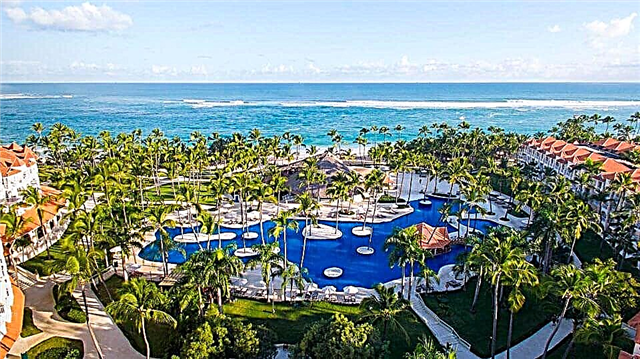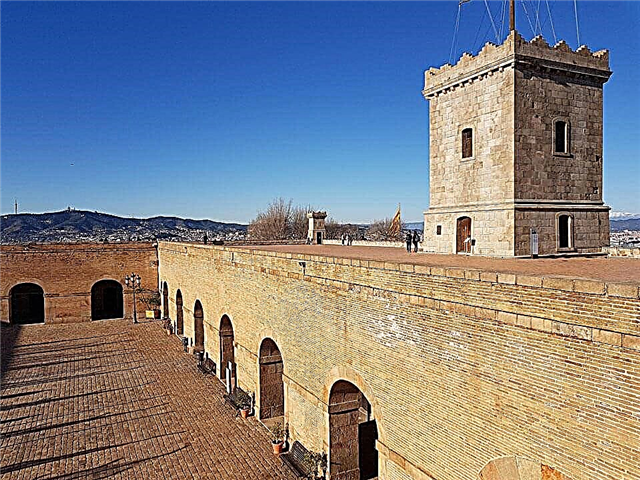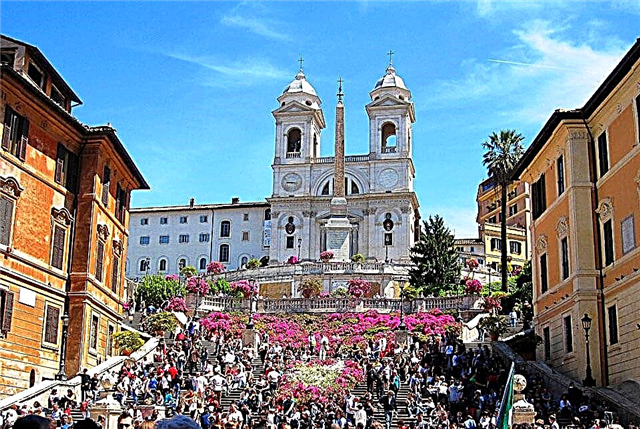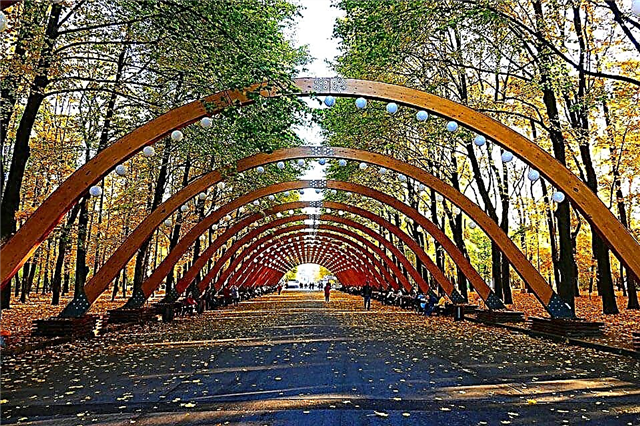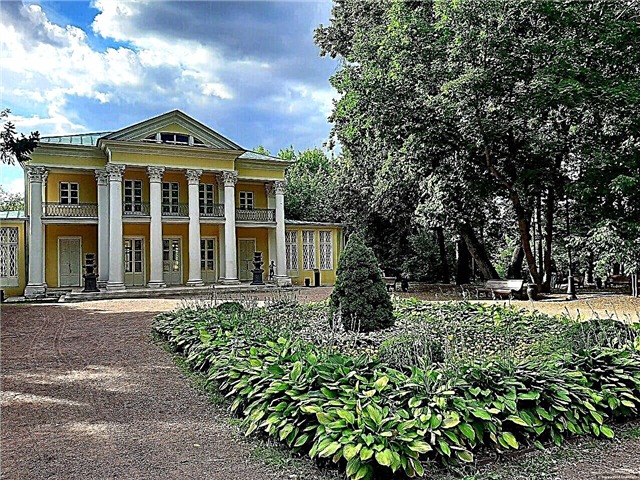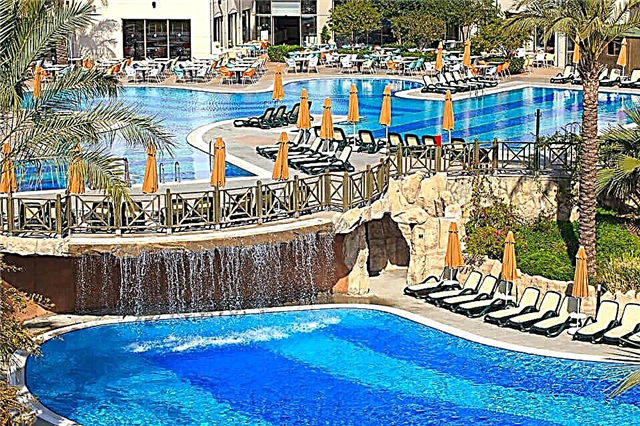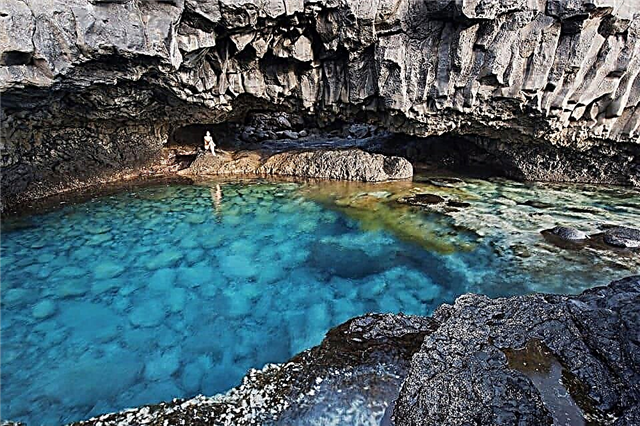The largest island in the Canary archipelago is also the most hospitable: the healing sands of Playa de la Arena or the vibrant coral reefs of Costa Adeje - Tenerife retains its almost homely atmosphere. Strong gusty winds blow on the beaches, but bend around warm lagoons with small towns, and reserves, botanical gardens and aquariums help to get acquainted with the richness of the nature of this island and preserve it.
The natural and man-made sights of Tenerife are organically combined with the nature of this rocky land, immersed in greenery, with the cold beauty of the Atlantic coast. However, Tenerife itself can hardly be called cold - it is often described as "the island of eternal spring", which is absolutely deserved. The mountains protect this tiny island of traditional culture that is not overrun by tourists.
Volcano teide

Teide attracted people back in the era of Antiquity and was mentioned more than once in the mythology of this period. Today, it is perhaps the most visited national park in Spain - it is grandiose from all observation platforms. There are five roads leading here. Each route is interesting: whether it be the road through Abona - the main wine-growing region of the country - and the "City of Flowers" or through Oratava - the valley known for the "stone flower".
The largest volcano in Europe is also the most breathtaking observation deck - not everyone will have enough endurance to first climb the cable car, and then walk another half of the way. It is worth remembering that access to the crater is only possible with a pass. If you have not bothered to issue a permit in advance, you can purchase it when you buy a cable car ticket.
Loro park

Loro Parque literally translates as "parrot park", but not only birds live here. The park was opened at the beginning of the twentieth century, and then it was really only home to parrots. It occupied only one hectare of space, and only one and a half hundred of these bright birds lived there. Today the area of the park is thirteen hectares, and more than four thousand birds live in it, which make up the largest collection of parrots in the world.
But Loro Parque can be proud of not only this record: it is here that the notorious shark tunnel is located, the largest colony of penguins living indoors. It is also one of the three European parks where killer whales breed and then live. The list of local inhabitants is too long. An adult ticket will cost 34 EUR, a child ticket 22 EUR. Working hours: 8:30 am - 6:45 pm.
Eagles Park Jungle Park

An ideal place for the whole family to visit is Orlov Park, in which, contrary to the name, not only eagles live, but almost the entire animal world, from quite peaceful fur seals to more dangerous predators: tigers, lions, crocodiles. Moreover, they do not live in open-air cages, but in natural conditions. A unique spectacle awaits guests - a performance with the participation of birds of prey, namely eagles, which is a rarity, since these birds are practically impossible to train.
Some - more harmless - predators can be fed. Those wishing to ride in the jungle can use the bobsleigh track. The price of an adult ticket (from 11 years old) is 26 EUR, the price of tickets for children varies depending on the height of the child. Orlov Park is open from 10:00 to 17:30.
Siam Park Waterpark

One of the most spectacular water complexes in Europe is designed in Thai style. The operation of the Siamese style of architecture had to receive permission from the royal family of Thailand itself, but the architect did not just copy famous temples and palaces, he created original fantasy buildings. It is noteworthy that due to the construction of the park, the natural landscape did not have to be destroyed, all the slides repeat the hilly terrain.
Buildings and attractions are concentrated here: the world's largest dragon statue, the "lazy river", which has the steepest rise. The park is inhabited by sharks and rays, which can be observed in the immediate vicinity, going down the "Tower of Power" slide. Children are joyfully frolicking in the "Lost City". The complex is open daily from 10:00 to 18:00.
Monkey park

Monkey Park is not as popular as, for example, Loro Park, but it is perfect for those guests who are not averse to getting to know lemurs and monkeys better. The territory is divided into a number of zones: the reptile zone, the alligator lake, the zone of primates and tropical birds. It is best to go to the park in the morning (from 09:30) or closer to closing (17:00), since in the middle of the day animals prefer to doze and are unlikely to react actively to your appearance. You shouldn't go to the park without bringing something tasty with you. True, you still have to give up bananas and dates.
The animals get fat from them, and you will be asked to leave these edible gifts outside the park. Admission for adults will cost only 10 EUR, and for children under 12 years old - 5 EUR. You cannot get here by public transport - you need a car.
Entertainment complex Lago Martianez

This complex consists of a system of artificial lakes on the Atlantic coast. It is located in the city of Puerto de la Cruz, that is, in the northern part of the island. Guests will find gentle beaches, homemade cafes, dozens of pools of various diameters, filled with sea water and lined with gardens, and even islands. The complex was opened at the end of the twentieth century, but then it included only two swimming pools. Children could swim in one, adults could swim in the other.
Instead of a modern ramified infrastructure, there was one bar. That all changed when a couple of talented architects set out to create a project that would combine the architecture of the archipelago with the latest from the world of technology. The integration was successful, and without understatement, this ambitious project was completed in the shortest possible time.
Concert Hall Auditorio de Tenerife

This futuristic structure was erected not at the peak of the popularity of modernism, but relatively recently - in 2003, instantly capturing the attention of tourists who come to Tenerife. This avant-garde in stone combines a concert hall and an opera house. Exterior inspection of the building is included in many excursion programs, but visiting it as a spectator will not hit your wallet. For example, the premiere of the musical Les Miserables could be seen for only 15 EUR, the most expensive tickets cost about 80 EUR.
It doesn't matter how much you will be willing to invest in a visit to the Auditorio de Tenerife - according to experts, this concert hall has almost the best acoustics in Europe. It is open from 10:00 am to 3:00 pm on all days except Saturday. It closes an hour earlier on Saturdays.
Museum of nature and man

The graceful neoclassical building that houses the museum's exhibits is an architectural monument as significant as the museum itself. Its exhibits are guaranteed to surprise you. That there is only one collection of mummies of the Guanche people, which has no analogues in the world! The richness of local collections is explained primarily by the fact that the creators tried to combine two museums: archeology and natural sciences, which was just brilliant.
The museum consists of several rooms, passing through which you can get acquainted with the cultural samples of different peoples (African masks, items of the Guanche religious cult, Egyptian ceramics), as well as with the local fauna in all its diversity. The full ticket price is 5 EUR. Also pay attention to night excursions.
Castle of San Miguel

A medieval castle, typical at first glance, is not such.This piece of medieval architecture in the spirit of the traditions of the Knights of the Round Table was erected in the vicinity of San Miguel especially for tourists who come to the island. But we must pay tribute to the architects - the chosen era has been thoroughly reproduced. Guests will be able to enjoy a real knightly tournament, see acrobatic stunts on horses and even attend a classic medieval revel, but be prepared for the fact that you will have to eat like a knight - down with knives and forks! Use your hands!
A visit to the castle will cost 51.30 EUR for an adult and 25.65 EUR - for a child. The show usually starts around 20:30. The castle is open during the summer on Tuesdays, Thursdays, Fridays and Saturdays.
Basilica of Candelaria

One of the most striking religious buildings in the Canary archipelago is the Basilica of Candelaria, which is located on the territory of the town of the same name. This Catholic church is distinguished by its external architectural austerity and consistency. The modern building of light stone was erected on the site of the old temple, which was decided to be demolished in the first half of the twentieth century.
Soon a tall chapel was added to the basilica, and the interior became truly magnificent. The face of Our Lady of Candelaria adorned the spacious room. It is also worth noting that not only believers and pilgrims flock here for large, even religious holidays, but also representatives of other confessions and just tourists - the basilica is in the epicenter of folk festivities, dances and fireworks.
Church of the Immaculate Conception of the Blessed Virgin Mary

The traditional Catholic church in the form of a Latin cross is the largest in the archipelago and consists of five naves. Once upon a time in its place there was a tiny chapel, which was erected by the Spanish knights, who landed in Tenerife. The place of construction was not chosen by chance - in the immediate vicinity of the church, Christian services were held several centuries before the arrival of the Spanish conquerors.
The modern church building was erected in modern times in the spirit of the Tuscan Baroque. From the old relics, there remains a figure of the Virgin Mary in the Gothic style, a crucifix of the sixteenth century and several older icons. The real pride of the church is the organ, which was created by London craftsmen and brought to the archipelago at the end of the nineteenth century.
Pyramids of Guimar

Perhaps the most significant archaeological site in Tenerife is the Pyramids of Guimar. Of course, they are not as impressive as the pyramids of the Aztecs or Egyptians, but the excursion to them will be no less informative. An ethnological park with a museum and a photo exhibition was laid out around the pyramids. The timing of the construction of the pyramids and the purpose of their construction are still questionable, as no settlements have been found in the vicinity.
After a series of studies, it was proved that the pyramids were built in such a way that all the stairs were facing the sun, and at the top of the highest of the pyramids on the day of the summer solstice, you can see a phenomenon that was attributed to special importance in ancient times - the double sunset. Entrance to the park for an adult will cost 18 EUR, for a child - 5.50 EUR.
Wind Caverns

Tenerife's underground landscape is almost more interesting than some of the aboveground attractions. In the bowels of the island are hidden networks of underground galleries and caves of lava origin. The Wind Caves were formed during the eruption of the Pico Viejo volcano. This large-scale network of crossings has not yet been fully studied by researchers and continues to vividly interest tourists.
It is noteworthy that the caves have three choir levels, which is not seen anywhere else in the world. Lava lakes, terraces, stalagmites and stalactites - all this forms a unique ecosystem. It is worth dressing warmer, because the caves got their name for a reason - strong air currents make the transitions breathe. The caves are open from Tuesday to Saturday. An adult ticket costs 16 EUR, a child ticket - 5 EUR.
Mask gorge

Maska Gorge persistently continues to attract hundreds of tourists not only for its colorful nature, but also for its reputation as a place where pirates and smugglers preferred to hide their treasures. According to legend, somewhere among the inaccessible rocks and deep grottoes, treasures continue to be kept. Along the narrow strip of the mountain serpentine, you can reach the village of the same name, in which a little more than a hundred people live.
The drive to the Mask will be quite stressful - the road to it is the steepest, and in some places the belt becomes too narrow even for two cars. However, there is no need to complain. Previously, it was possible to get here only along mountain paths. But it's worth it: panoramic views, traditional Canarian architecture, Gingerbread House and national cuisine with gofio and purple mojo sauce await you.
Infierno gorge

Devil's Gorge more than lives up to its name. The first thing you need to know is that this unique natural oasis with ravines and a waterfall is a protected area, and therefore no more than three hundred people can be here at the same time, so as not to disturb the natural ecosystem. You can book a ticket for a visit on the official website - it will cost 8 EUR, while a guided tour will cost 15 EUR. A walk along the gorge will take about three hours.
It is one of the best natural viewpoints - it offers absolutely stunning views of the southern tip of Tenerife. A narrow hiking trail passes by numerous rock formations and lush tropical vegetation. You will see the ancient grottoes, where the locals buried mummies, and fully enjoy the vibrant beauty of this corner of Spain.
Cliffs de Garcia

This rock group in the Las Cañadas caldera is the island's second most visited natural attraction. Perhaps the most famous of the cliffs is Sinchado, which is most often depicted on postage stamps and postcards from Tenerife. It has an unusual shape and is likely to collapse sooner or later, finally undermined by water and wind. According to rough estimates, the age of the de Garcia rocks is about one hundred and seventy thousand years.
The unusual relief of the caldera attracts not only tourists, but also filmmakers: it was here that some episodes of "Planet of the Apes" and "Star Wars" were filmed. The territory of the caldera is protected, as rare species of herbs grow here, and therefore access here is limited. The excursion program should be agreed in advance.
Rocks of Los Gigantes

Hell's walls loom eerily over the west coast of Tenerife. Even the ancient peoples living on the island experienced an almost sacred awe for these basalt formations. The rocks rise with an almost six-hundred-meter ridge above sea level and look especially impressive if you look at them from below - from a boat or ferry. Many boats are moored to the pier of the town of the same name, which huddles at the foot of Los Gigantes.
The settlement is located in a cozy bay, which makes this area especially convenient for ocean fishing and diving. You should take the time to look directly at the Hell's Walls - there are cracks in the basalt large enough for a person to squeeze through, and entire gorges. Behind them are wild beaches and small grottoes.
Orotava Valley

The Orotava Valley is almost close to the chain of peaks of Las Cañadas, which, when viewed from a height, forms an almost perfect square. Orotava appeared due to the descent of fossilized lava rocks, the remains of which bend around the eastern and western ends of the valley. It got its name in the sixteenth century in honor of the settlement of the same name, founded by the conquistadors. Even then - in the Middle Ages - La Orotava was famous for its vibrant national architecture.
Today, the former stronghold of the conquistadors is the unofficial capital of the valley, which is dotted with hiking trails. Walking along them is designed for thoughtful - most often solitary - admiring the luxury of the local landscapes. And there is something to admire! The land of Orotava is perhaps the most fertile on the island.
Anaga park

The territory of the park is rich in landscapes: rocky gorges, pointed peaks, rocks, and all this is covered with a soft carpet of evergreen forest. But this reserve is famous not only for the relief of the soil, but also for the uniqueness of the local natural world. The almost inaccessible mountains that border the park have made it possible to preserve the local flora in the state it was in hundreds of years ago.
The so-called subtropical laurel thickets are of particular value.
For tourists, trails have been laid that allow them to more fully explore the natural resources of the park. Almost all of them pass through Roque de Taborno - the highest point of Anaga. On the territory of the reserve, ancient settlements and more modern villages are hidden, in which remnants of the national culture and crafts are glimmering.
Puerto de la Cruz Botanical Garden

The Madrid Botanical Garden is the oldest institution of its kind in Spain, while the second place rightfully belongs to the Puerto de la Cruz garden, which was laid out in 1788, but not as a botanical garden, but as a kind of transit point. Rare species of exotic plants were to be brought here, which needed acclimatization before being transported inland.
Gradually, this place turned into a kind of Mecca for fans of botany and just one of the most popular tourist attractions in Tenerife. Puerto de la Cruz occupies the eastern end of the city. It is open from 09:00 to 18:00. The entrance ticket will cost only 3 EUR. The guide will introduce you to more than four thousand collection of plants from all over the world.
Dragon tree

The most famous tree of the archipelago grows in the park of the same name and is the symbol of the city. His image adorns the local coat of arms. Scientists continue to argue about the real age of this ancient giant. Most of them give it from eight hundred to a thousand years. The determination of its age is complicated by the fact that the Dragon tree belongs to the dracaena, which, as you know, do not have tree rings.
The first time you see it live, you are inevitably surprised: the diameter of the trunk is as much as twenty meters, while its height barely crosses the mark of eighteen meters. If a modern man is struck by this view, imagine the thrill that this giant caused among local residents hundreds of years ago - the tree itself was considered sacred, and its sap was used during the burial ritual.
Taoro Park

In the heart of old Puerto de la Cruz, on a sloping hill, is the Taoro Park. It is the ideal location for a leisurely, quiet stroll away from the crowds. The air rings from the aromas of exotic flowers and trees, the soft play of water from fountains and waterfalls ideally complements the atmosphere. Guests of the city and local residents do not hesitate to call this park one of the most comfortable places to relax.
The green lungs of Puerto de la Cruz are conditionally divided into three zones: the pride of the first is the observation deck, which offers the best urban panorama in the area; the second got its name from the casino, which is housed in the luxurious building of the oldest hotel in the archipelago; and the third zone is a corner for athletes and joggers. You should not enter here without sneakers - you run the risk of being misunderstood.
Natural Pools El Caleton

The amazingly beautiful bodies of water that adorn the city of Garachico appeared due to the volcanic activity of Montaña Negra. The first landslides were observed here in the seventeenth century, according to the preserved records. Then the catastrophe took many lives and practically destroyed part of the city. The remains of the buildings were buried under a layer of lava. The incandescent streams melted the stone, forming hundreds of small lakes of original shape.
They do not repeat each other either in depth or in size, but this is what attracts guests. One observation of the lakes is already causing delight - the bottom of the reservoirs consists of black stones, which froze, reaching at a certain moment to a liquid state. But with swimming, you should be careful - sometimes extremely high waves rise here.
Cape Teno

This promontory crowns the northwestern tip of Tenerife. From here there is a beautiful view of the Log Gigantes basalt cliffs, which hang low over the ocean surface. Traveling to the cape is a rather dangerous undertaking, which is unobtrusively reminded by numerous signs. You will have to drive through several tunnels, as well as sections of serpentine roads that run close to the cliff.
Due to strong winds, which are not uncommon for this part of the archipelago, there are occasional rockfalls that block the roads. But once at the top, it seems that you find yourself in a kind of vacuum - silence and calm. Here you can sit for a very long time, gazing at the deserted beach and the silhouette of the lighthouse, which looks even more lonely among the rocky ridges.
Teide Observatory

The Teide Observatory is not only one of the most important institutions that study the starry sky, but also an important part of the natural complex of the same name. A successful combination of modern technical equipment and an optimal geographical position brings it to a leading position among the world's observatories.
A number of premises are closed to the public, but the Tower Vacuum Telescope, the Solar Laboratory and some others are included in the excursion programs. On open days - usually two days in summer - admission to the Teide Observatory is free. The schedule of these days is constantly changing. If you want to visit the observatory privately, you need to sign up for an excursion. The cost will vary from 17 to 40 EUR.



